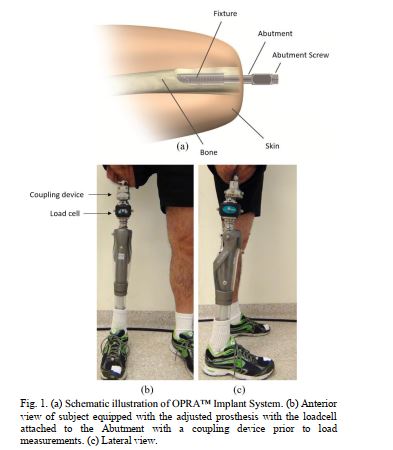Clinical Research Quantifies Loads for Osseointegrated Lower Limb Prostheses

Prosthesis acceptance is a major determinant of people’s quality of life after amputation. Along with factors such as phantom limb pain, misaligned expectations for prosthesis, psychological adjustment and functionality, prosthetic socket issues are a primary reason for prosthesis rejection. Compression and friction forces imposed by the prosthetic socket on the skin of the residual limb results in problems ranging from discomfort in the stump to blisters, superficial infections to cancerous and non-cancerous tumors 1,2. Direct skeletal attachment of the limb prosthesis offers an effective solution to overcome these problems. The OPRA™ Implant System by Integrum AB was the first clinically viable osseointegration system in 1990, pioneering the field of bone-anchored prosthesis for amputation rehabilitation.
Researchers from the Sahlgrenska Academy of Clinical Sciences at the University of Gothenburg, Chalmers University of Technology, and Integrum AB recently published a study on the load exposure of the bone-anchored implant system during free and aided ambulation with the OPRA™ Implant System3. The study published in the IEEE Transactions on Medical Robotics and Bionics reports on 20 recipients of the OPRA™ Implant System, between the ages of 26 and 73, who performed level walking, ascending and descending slopes and stairs, while loads at the implant-prosthesis interface were measured. In addition, the study quantified how much the loads were reduced by walking with the support of an aid such as a walking stick or a crutch. This study provides quantitative information that can aid in personalized rehabilitation programs, walking strategies, and recommendations on the extent of walking aid usage.
With proven improvements in the quality of life4,5 and increasing clinical acceptance of osseointegration as a solution to prosthetic socket problems, there is a need to expand the technical knowledge in the field of Osseointegration of Limb Prosthetics. As the pioneer in this field, Integrum AB supports and celebrates the value of this research to the Osseointegration community.
REFERENCES
[1]Hagberg K, Brånemark R. Consequences of non-vascular trans-femoral amputation: a survey of quality of life, prosthetic use and problems. Prosthet Orthot Int. 2001;25(3):186-194. doi:10.1080/03093640108726601
[2] Levy, S. W. Skin problems of the leg amputee. Prosthet Orthot Int. 1980;4(1), 37–44. https://doi.org/10.3109/03093648009103113
[3] A. Thesleff, E. Häggström, R. Tranberg, R. Zügner, A. Palmquist and M. Ortiz-Catalan, „Loads at the implant-prosthesis interface during free and aided ambulation in osseointegrated transfemoral prostheses. IEEE Transactions on Medical Robotics and Bionics. 2020 doi: 10.1109/TMRB.2020.3002259.
[4] Hagberg K, Häggström E, Uden M, Brånemark R. Socket versus bone-anchored trans-femoral prostheses: hip range of motion and sitting comfort. Prosthet Orthot Int. 2005;29(2):153-163. doi:10.1080/03093640500238014
[5] Häggström, E., Hagberg, K., Rydevik, B., & Brånemark, R. (2013). Vibrotactile evaluation: Osseointegrated versus socket-suspended transfemoral prostheses. J Rehabil Res Dev, 50(10), 1423–34.
